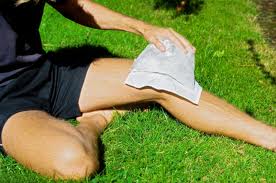Knee bursitis is the inflammation of a bursa found near the joint of the knee. A bursa is a pad-like sac that is filled with fluid that lessens friction and cushion pressure points between the bones and tendons and muscles that are near the joints.
[youtube url=”https://www.youtube.com/watch?v=CZ18PGwUG-0″]Each of the knees has 11 bursae. When any of the bursae becomes inflamed, it can result to knee bursitis that happens over the knee cap or on the inner area of the knee below the joint. Knee bursitis can cause pain and limited movement.
Symptoms of knee bursitis
- Movement is limited or stiffness of the knee
- Pain and tenderness of the knee

Apply an ice pack on the affected knee for at least 15-20 minutes for several times every day until the pain is minimized and the knee does not feel warm when touched. - Red, warm, swollen skin over the knee
Causes
- Bacterial infections of the bursa
- An injury such as falls
- Constant pressure on the knees such as kneeling when gardening and cleaning the floor.
- Overusing of the knee such as running and jumping
- Suffering from underlying conditions such as rheumatoid arthritis, osteoarthritis and gout of the knee.
Treatment
- Apply an ice pack on the affected knee for at least 15-20 minutes for several times every day until the pain is minimized and the knee does not feel warm when touched. Avoid applying directly on the skin to help prevent frostbite and making the condition worse. Use an ice pack or crushed ice placed in a plastic bag and wrapped with a towel before placing on the affected area.
- Take plenty of rest to help lessen pain and swelling, avoid performing activities that can result to bursitis and avoid unnecessary movements that makes the condition worse.
- Apply heat on the affected area for at least 15-20 minutes at 3-4 times every day to lessen stiffness and pain in the area.
- Wrap the knee using tape or an elastic bandage to help lessen the swelling. Avoid wrapping it too tight to prevent disruption of blood circulation in the area.
- Elevate the knee above the level of the heart by propping up the affected area on pillows. This helps minimize the swelling and pain in the knee.
Seek the help of the physical therapist for exercises that helps improve mobility and strength as well as lessen pain of the affected area.
Tips
- Always perform stretching, warming up and cooling down exercises before and after a workout to loosen the tight muscle and minimize stress on the knees. It is vital to take a rest between workouts.
- Protect the knees by using kneepads when kneeling on hard surfaces and when playing sports. Stand and walk around at least every 20 minutes if kneeling for a longer time.
- Seek medical help immediately if swelling and pain becomes severe along with fever.
